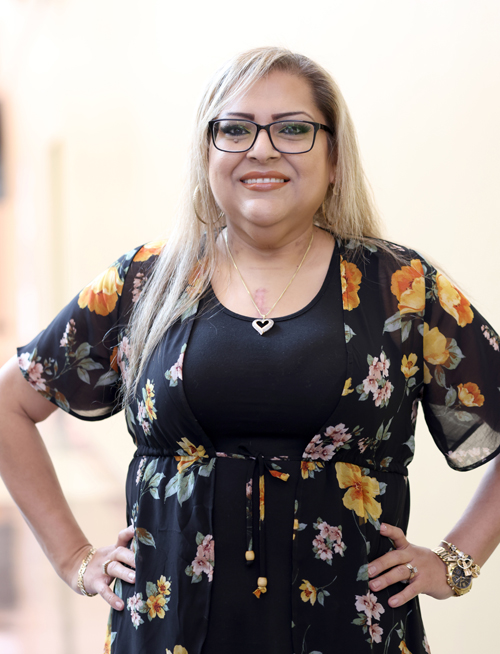by Matt Batcheldor

When Veronica Llamas-Barajas received a heart transplant at Vanderbilt University Medical Center in April, it was the culmination of a seven-year journey. Back then, her doctor told her she had end-stage heart failure and had maybe six months to live. She needed a heart transplant, but her weight was too high to qualify. She was 36 years old.
Her doctor referred her to Vanderbilt. She did not initially qualify for a transplant, but she could receive a left ventricular assist device (LVAD), an implantable, mechanical support system to pump blood through the body when the heart is too sick to do it.
“Patients can live permanently with LVADs or use them as a bridge to transplant,” said Sandip Zalawadiya, MBBS, medical director of the Ventricular Assist Device Program at Vanderbilt. “Our hope was that the LVAD would not only give her a chance to live longer, but also make more resources available to her to help lose weight and become a heart transplant candidate.”
Llamas-Barajas received her LVAD in 2018 at Vanderbilt, and in August 2021, she became the first LVAD patient in Tennessee to undergo bariatric surgery, in hopes of reducing her weight to qualify for a transplant. Right before her weight loss surgery, she weighed 297 pounds. At the beginning of April 2022, when she weighed 212 pounds, she got the news that she qualified for the transplant list.
Two weeks later, she got “the call” that her new heart was available, and she was transplanted. Her hopes were fulfilled. As of early September 2022, Llamas-Barajas weighs 187 pounds, and with her new heart, she is looking forward to a long life.
“It was painful. It was hard. But it was worth it,” she said. “I’m just happier right now. It’s just a whole lot better for me now.”
Post-transplant, Llamas-Barajas is getting accustomed to what a “normal” heart feels like. She had forgotten. “I didn’t know what a real heart felt like for seven years,” she said.
“I am so happy for Veronica,” Zalawadiya said. “She has opened a new door for many patients. She is a genuine inspiration to many, including me and my team. We now have a road map for success at Vanderbilt for patients suffering with advanced heart failure and obesity.”

In August 2021, Llamas-Barajas underwent a sleeve gastrectomy, the most common bariatric surgery performed in the U.S., in which 80% of her stomach was removed, leaving it the size and shape of a banana. Patients will lose, on average, approximately 50-60% of their excess weight at one year, said her surgeon, Wayne English, MD, associate professor of Surgery and director of Clinical Research for the Vanderbilt Center for Surgical Weight Loss.
Llamas-Barajas exceeded that goal, losing 87%, English noted.
“I am so proud of Veronica,” English said. “She was determined to succeed and followed all the recommendations after her surgery to accomplish her goals. I was quite emotional to learn that Veronica received her heart transplant. This was an amazing moment for Veronica and a major milestone for VUMC. We could not have helped her if it were not for the team of individuals required to operate a complex advanced heart failure program for patients with obesity and develop a pathway for heart transplantation.”
To qualify for the procedure, Llamas-Barajas, like all other weight loss surgery candidates, was required to participate in months of medical weight management and psychological counseling to ensure that she was a good candidate to keep the weight off after surgery. Patients must make wholesale life changes, including managing an altered sense of hunger and dietary requirements after the surgery.
Before her weight loss surgery, everyday tasks were hard.
“Usually, it was like take a shower, get out of the tub, hold onto the wall and catch my breath,” she said. “And then walk to the bed and catch my breath again.”
Llamas-Barajas followed her doctors’ advice, eating a healthy diet and working out several times a week. She works out at Dayani Center once or twice a week and goes to a gym near her house on other days.
“I’m able to walk all over now,” she said. “I used to use the little (electric) carts at the grocery stores. Now I walk instead. I do a lot more things.”
Llamas-Barajas complimented her care team at Vanderbilt.
“I can never thank them enough,” she said. “The nurses, the staff… they’re awesome. They’re amazing people, and God bless them, because they blessed me.”
Several members of both the LVAD and bariatric surgery teams played a crucial role in Llamas-Barajas’ success, including but not limited to Jessica Hassler, RN (VAD coordinator), Casey West, ANP (VAD nurse practitioner), Robert Tunney, PharmD (VAD pharmacist), Wendy Tarpley, BSN, RN (Bariatric Program Coordinator, Vanderbilt Weight Loss) and Jan Lemanski, BSN, RN (Clinic Nurse, Vanderbilt Weight Loss).












